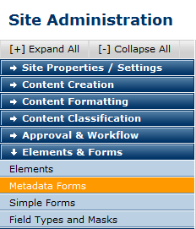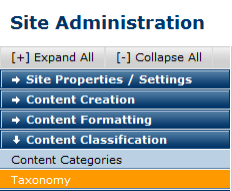
CommonSpot’s extensive metadata (information about information) layer allows any designated administrator to selectively bind specific metadata to templates, subsites, page categories, pages, documents, document types and/or render handlers. This allows for the controlled collection of information that can later be used for easy content retrieval, classification, and reuse.

Without additional programming or development expertise, you can specify and use both standard (for example, title, description, creator, etc.) and custom metadata (categories that you define) to intelligently build rich information classes. The ability to define your own business rules for classifying data provides many benefits, including:
For example, your site can personalize or target content, dynamically render layouts, and improve user access to site information.
For more on CommonSpot's extensive metadata support, see Metadata Forms Overview and Custom Elements.
Organizations faced with the problem of making vast and growing collections of data relevant to site visitors are increasingly turning to taxonomy-based data classification and facet-based navigation to produce a better search and discovery experience.

Taxonomies create order out of large collections of data by classifying items in a way that shows the relationship between them. The strength of the approach derives from its ability to define a term's relationship to other terms, even for single terms associated with multiple meanings, enabling a much more detailed expression of relationships than strictly hierarchical models permit. In addition to the ability to define related and equivalent terms, this approach to classification also makes it possible to implement an Amazon-like “recommendation engine” to find items defined in similar topic areas within the same taxonomy.
Because taxonomy systems classify data using terms already defined, data associated with one or more terms inherits existing properties and relationships, reducing the work involved in classifying new information. This effect is bidirectional: as the taxonomy improves and updates occur, new associations become effective for existing data without requiring manual reclassification of data.
CommonSpot’s complete, out-of-the-box, taxonomy management offers a taxonomy term editor, a taxonomy API, and a facet-based navigation Element for defining "broader than" and "narrower than" relationships between terms. Organizations can rapidly assign content to terms using the taxonomy classification custom metadata field. Developers using the taxonomy API to programmatically access terms and relationships within a taxonomy can build unlimited custom interfaces to related content.
CommonSpot adheres to the ANSI Z.39 standard, enabling the definition of taxonomies that meet critical business requirements.
For more information, see Taxonomy .
Related Links
You can download PDF versions of the Content Contributor's, Administrator's, and Elements Reference documents from the support section of paperthin.com (requires login).
For technical support: